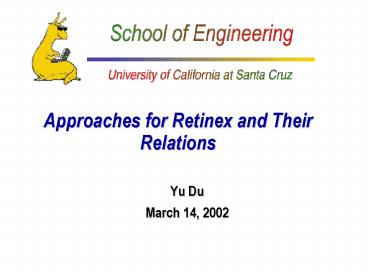Approaches for Retinex and Their Relations
1 / 23
Title:
Approaches for Retinex and Their Relations
Description:
Homomorphic filtering. Low-pass filtering first or log first? ... Apply appropriate scaling on images, Homomorphic filtering satisfies constrain. and ... –
Number of Views:81
Avg rating:3.0/5.0
Title: Approaches for Retinex and Their Relations
1
Approaches for Retinex and Their Relations
- Yu Du
- March 14, 2002
2
Presentation Outline
- Introductions to retinex
- Approaches for retinex
- The variational framework
- Relation of these approaches
- Conclusions
3
What Is Retinex
- Lightness and retinex theory
- E. H. Land 1971
- Visual system of human
- Retina the sensory membrane lining the eye that
receives the image formed by the lens (Webster) - Reflectance and illumination
- Edges and independent color senstion
4
Model of retinex (1)
The given image
The illumination part
The reflectance part
5
Model of retinex (2)
Log
Exp
Input Image
Estimate the Illumination
6
Three Types of Previous Approaches
- Random walk algorithms
- E. H. Land (1971)
- Homomorphic filtering
- E. H. Land (1986), D. J. Jobson (1997)
- Solving Poisson equation
- B. K. P. Horn (1974)
7
Random Walk Algorithms (1)
- First retinex algorithm
- A series of random paths
- Starting pixel
- Randomly select a neighbor pixel as next pixel on
path - Accumulator and counter
8
Random Walk Algorithms (2)
- Adequate number of random paths
- Cover the whole image
- Small variance
- Length of paths
- gt200 for 10x10 image (D. H. Brainard)
9
Special Smoothness of Random Walk
- The value in the accumulator
- The illumination part
10
Homomorphic Filtering
- Assume illumination part to be smooth
- Apply low pass filter
11
Poisson Equation Solution (1)
- Derivative of illumination part close to zero
- Reflectance part to be piece-wise constant
- Get the illumination part
- Take the derivative of the image
- Clip out the high derivative peaks
12
Poisson Equation Solution (2)
- Solve Poisson equation
- Iterative method
- Apply low-pass filter (invert Laplacian operator)
13
Comments on Above Approaches
- Random walk algorithm
- Too slow
- Homomorphic filtering
- Low-pass filtering first or log first?
- More work needed to be done on Poisson equation
solving
14
Variational Framework
- Presented by R. Kimmel etc.
- From assumptions to penalty function
- From penalty function to algorithm
15
Assumptions On Illumination Image
- Spatial smoothness of illumination
- Reflectance is not pure white
- Illumination close to intensity image
- Spatial smoothness of reflectance
- Continues smoothly beyond boundaries
16
Penalty Function and Restrictions
- Goal to minimize
- Subject to
- And on
17
Solve the Penalty Function (1)
- Euler-Lagrange equations
- And
18
Solve the Penalty Function (2)
- Projected normalized steepest descent (PNSD)
- Iteratively to get illumination part
19
Multi-resolution
- Make PNSD algorithm converges faster
- Illumination part is smooth
- Coarse resolution image first
- Upscale coarse illumination as initial of finer
resolution layer - Not multi-scale technique
20
Relationship of Different Approaches (1)
- Random walk and Homomorphic filtering
- R. Kimmels words on Homomorphic filtering
- and remove constraint
21
Relationship of Different Approaches (2)
- Apply appropriate scaling on images, Homomorphic
filtering satisfies constrain - and
- Poisson equation approach
22
Conclusions
- Retinex is trying to simulate human vision
process - Different approaches are from same assumptions
- Implementation details are important for results
23
Thank You
- March 14, 2002































